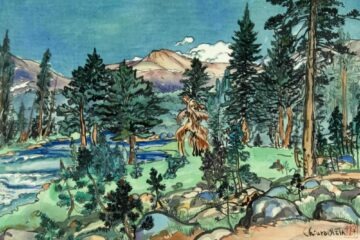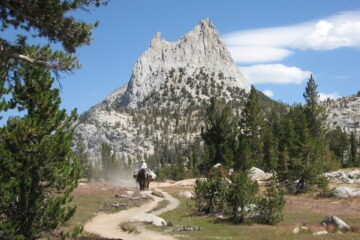Sate your scientific curiosity with this snowy brain-snack prepared by our lead naturalist, Cory!
Snow is always exciting here in Yosemite. It can drastically change the landscape, makes winter a breathtakingly beautiful season in the park, and helps nourish the state of California.
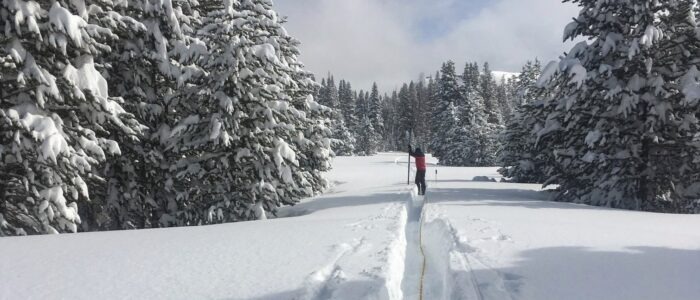
The Tuolumne Meadows winter rangers measured snow levels in the high country in late January 2021. Photo: NPS/Laura and Rob Pilewski.
When you picture snow, you probably imagine a blanket of white. But did you know that snow can be … pink?
If you hike at high elevations in Yosemite (above 10,000 feet), you may come across large patches of pink or reddish snow. (It’s especially common around May Lake, if you’re up there in the early part of the season when Tioga Road reopens.) At first, you might think the altitude is affecting your vision, or that your sunglasses are creating a strange glare. In fact, what you’re seeing is a phenomenon called “watermelon snow.”
Observations of pink snow go way, way back: The Greek philosopher Aristotle mentioned the phenomenon in his writings more than 2,300 years ago. For years, the mysterious watermelon snow puzzled alpine climbers, explorers and naturalists. Some even thought it was caused by mineral deposits or oxidation products leached from rocks.
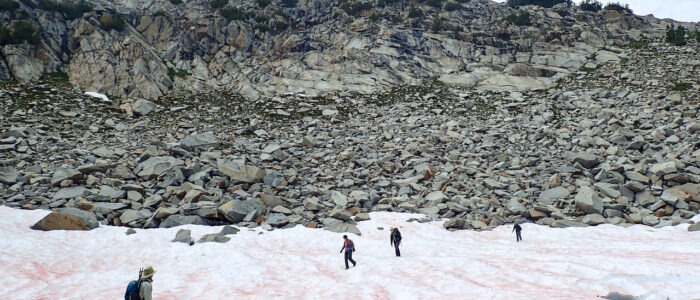
Participants on a Yosemite Conservancy Outdoor Adventure backpacking trip to Mt. Lyell in 2017 cross a slope streaked with “watermelon snow.” Photo: Roy Williams Photography.
Scientifically speaking, when you’re looking at watermelon snow, you’re seeing Chlamydomonas nivalis, a species of algae that contains both green pigment (chlorophyll) and red pigment (carotenoid).
Unlike other algae, Chlamydomonas nivalis thrives in cold or freezing water. The red pigment acts like sunscreen for the algae: It protects chloroplasts, the structures where chlorophyll captures and converts energy from sunlight, from intense visible and ultraviolet radiation. The pigment also helps keep the algae hydrated, by absorbing heat and prompting snow to melt into liquid water.
We’ve all been told not to eat yellow snow (for good reason!), but what about pink snow? While the nickname “watermelon snow” hints at a refreshing alpine treat for a dehydrated hiker, beware: It can have laxative effects.
As the weather increasingly warms, we’re seeing more algae blooms on large snowpacks. When warmer temperatures melt snow, more algae grows, taking advantage of the liquid water; the dark algae absorbs light, and causes more snow to melt. On a global scale, this feedback loop accelerates glacial melting and contributes to rising sea levels.
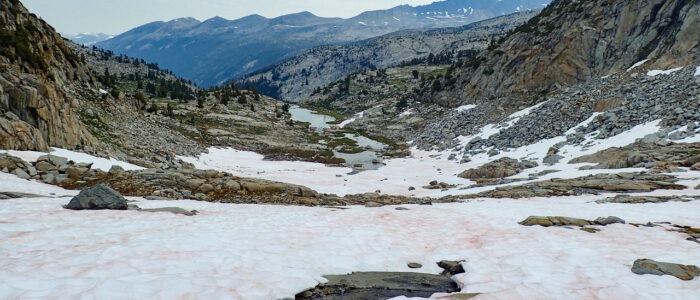
A snow field with pink patches of Chlamydomonas nivalis in eastern Yosemite. Photo: Roy Williams Photography.
Want to learn more about snow in the Sierra Nevada? If you’re planning a trip to the park, sign up for an Outdoor Adventure or Custom Adventure to learn in person with one of our naturalist guides.
Above: Naturalist Pete Devine stands in front of the remains of the glacier on Mt. Lyell in summer 2017. Photo: Roy Williams Photography.


